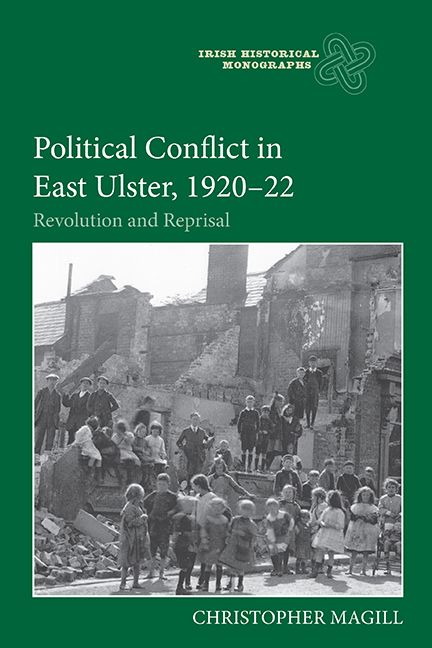Book contents
- Frontmatter
- Dedication
- Contents
- List of Illustrations
- Acknowledgements
- Abbreviations
- A Note on Terminology
- Map
- ‘Cork Justice Travelled a Long Way’: the Assassination of District Inspector Oswald Swanzy
- 1 From Moderates to Militants: the Unionist Community in East Ulster
- 2 Reprisal: the East Ulster Riots
- 3 ‘A Vital But Unenviable Task’: Understanding Loyalist Violence
- 4 A Protestant Force: the Social Composition of the B Specials
- 5 The Wilder the Better? Explaining the Violence of the Ulster Special Constabulary
- 6 A Misunderstood Minority: Irish Nationalists
- Conclusion
- Bibliography
- Index
- Irish Historical Monographs Previous Volumes
3 - ‘A Vital But Unenviable Task’: Understanding Loyalist Violence
Published online by Cambridge University Press: 21 October 2020
- Frontmatter
- Dedication
- Contents
- List of Illustrations
- Acknowledgements
- Abbreviations
- A Note on Terminology
- Map
- ‘Cork Justice Travelled a Long Way’: the Assassination of District Inspector Oswald Swanzy
- 1 From Moderates to Militants: the Unionist Community in East Ulster
- 2 Reprisal: the East Ulster Riots
- 3 ‘A Vital But Unenviable Task’: Understanding Loyalist Violence
- 4 A Protestant Force: the Social Composition of the B Specials
- 5 The Wilder the Better? Explaining the Violence of the Ulster Special Constabulary
- 6 A Misunderstood Minority: Irish Nationalists
- Conclusion
- Bibliography
- Index
- Irish Historical Monographs Previous Volumes
Summary
I
The struggle for independence from Britain occupies a central position in the Irish national narrative. The pivotal role of the IRA in gaining independence has been subject to extensive historical inquiry. While the IRA was central to the success of the revolution in the south, the actions of northern loyalists were as important in explaining why the revolution failed across much of Ulster. Their role has nonetheless received limited attention from historians, perhaps because the emphasis on this period, both by the state and its political parties, has been much greater in the south. There was, for example, no northern equivalent to the Bureau of Military History, established by the southern state to preserve historical knowledge of the conflict, and there has been a much smaller output of popular histories and memoirs from unionist and loyalist perspectives. Whereas the Irish Free State owed its existence to the Irish Volunteers who, from a republican perspective, conducted a heroic struggle for independence from Britain, the Unionist Party was less inclined to draw attention to a period in which the British government effectively ceded its authority over a considerable part of its territory. Consequently, much less is known about the role played by the UVF (post-1914), USC and Royal Ulster Constabulary (RUC) in contributing to the establishment of Northern Ireland.
Understanding the purpose of loyalist violence, examples of which were discussed in the previous chapter, offers a good place to begin addressing this historiographical gap. Some commentators have asserted that the goal of loyalists was nothing more than ethnic cleansing. Although the forced expulsion of Catholics from Banbridge, Dromore, Lisburn and Newtownards in the summer of 1920 cannot be disputed, it does not necessarily follow that the aim was to create ethnically homogeneous areas. To ensure this, loyalists would have had to sustain their intimidation of Catholics, rendering their return to these towns impossible. However, many Catholics did return, although continued sectarian feeling was also noted by the police. Alternative explanations may, therefore, be necessary to understand loyalist motives and aims.
One explanation of this violence can be found in how militant loyalists viewed the Catholic community. A tradition of anti-Catholic rioting existed in Ulster, rooted, in part, in Protestant anxieties about the threat posed by Catholics.
- Type
- Chapter
- Information
- Political Conflict in East Ulster, 1920–22Revolution and Reprisal, pp. 63 - 79Publisher: Boydell & BrewerPrint publication year: 2020



